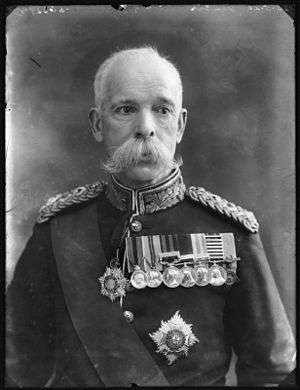Arthur Wynne (British Army officer)
| Sir Arthur Wynne | |
|---|---|
|
Gen. Sir Arthur Wynne | |
| Born | 5 March 1846 |
| Died | 6 February 1936 (aged 89) |
| Allegiance |
|
| Service/branch |
|
| Years of service | 1863–1911 |
| Rank | General |
| Commands held |
10th Division 6th Division |
| Battles/wars |
Second Anglo-Afghan War Mahdist War Second Boer War |
| Awards | Knight Grand Cross of the Order of the Bath |
General Sir Arthur Singleton Wynne GCB (5 March 1846 – 6 February 1936) was a senior British Army officer who went on to be Military Secretary.
Military career
Wynne was commissioned into the 51st Regiment of Foot in 1863.[1] He became Adjutant of his Regiment in 1868.[2]
In 1877 he became Superintendent of Army Signalling during the Iowaki campaign.[1] He served in the Second Anglo-Afghan War from 1878 and was Commander of Field Telegraphs with the Karum Valley Field Force.[1] In 1885 he was decorated for service in Sudan[3] and by 1889 he was Deputy Assistant Adjutant General at Army Headquarters.[4]
By 1891 he was Assistant Adjutant-General at the Curragh.[5] He joined the General Staff at Malta and then transferred to Aldershot.[1]
He served in the Second Boer War and was made Deputy Adjutant-General for the Natal Field Force in South Africa[1] and after the Battle of Spion Kop he was given command of the 11th infantry brigade in place of General Edward Woodgate who was killed.[6][7] During the Battle of the Tugela Heights Wynne was himself slightly injured and his command was given to Colonel Walter Kitchener.[8] After recovering, he was appointed in command of the Cape Colony District until his return to the United Kingdom in early 1902.[9] He was appointed Deputy Adjutant-General to the Forces on 14 May 1902,[10] General Officer Commanding 10th Division within IV Army Corps and General Officer Commanding Eastern District in 1904 and General Officer Commanding 6th Division in 1905.[11] He went on to be Military Secretary in 1906.[12]
In retirement he was promoted general and became Keeper of the Jewel House, holding the office from 1911 to 1917.[13] From 1913 to 1927 he also held the colonelcy of the King's Own Yorkshire Light Infantry.
He lived at Haybergill near Warcop and served as Deputy Lieutenant of Westmoreland.[14]
References
- 1 2 3 4 5 Brigadier-General Wynne Thames Star, 1900
- ↑ The London Gazette: no. 23386. p. 3124. 2 June 1868. Retrieved 2010-05-07.
- ↑ The London Gazette: no. 25515. p. 4557. 29 September 1885. Retrieved 2010-05-07.
- ↑ The London Gazette: no. 25946. p. 3289. 18 June 1889. Retrieved 2010-05-07.
- ↑ The London Gazette: no. 26167. p. 2922. 30 May 1891. Retrieved 2010-05-07.
- ↑ Churchill, W.S. London to Ladysmith via Pretoria, London: Longmans, Green & Co. 1900, ch. XX
- ↑ "The War – Appointments". The Times (36056). London. 3 February 1900. p. 12.
- ↑ Churchill, W.S. London to Ladysmith via Pretoria, London: Longmans, Green & Co. 1900, ch. XXII
- ↑ The London Gazette: no. 27408. p. 1037. 18 February 1902.
- ↑ The London Gazette: no. 27433. p. 3179. 13 May 1902.
- ↑ Army Commands Archived 5 July 2015 at the Wayback Machine.
- ↑ The London Gazette: (Supplement) no. 28034. p. 4430. 25 June 1907. Retrieved 2010-05-07.
- ↑ The London Gazette: no. 28539. p. 7281. 6 October 1911. Retrieved 2010-05-07.
- ↑ The London Gazette: no. 32518. p. 9058. 15 November 1921. Retrieved 2010-05-07.
| Military offices | ||
|---|---|---|
| Preceded by Herbert Plumer |
GOC Eastern District and 10th Division (renamed 6th Division in 1905) 1904–1906 |
Succeeded by Theodore Stephenson |
| Preceded by Sir John Spencer Ewart |
Military Secretary 1906–1911 |
Succeeded by Sir William Franklyn |
